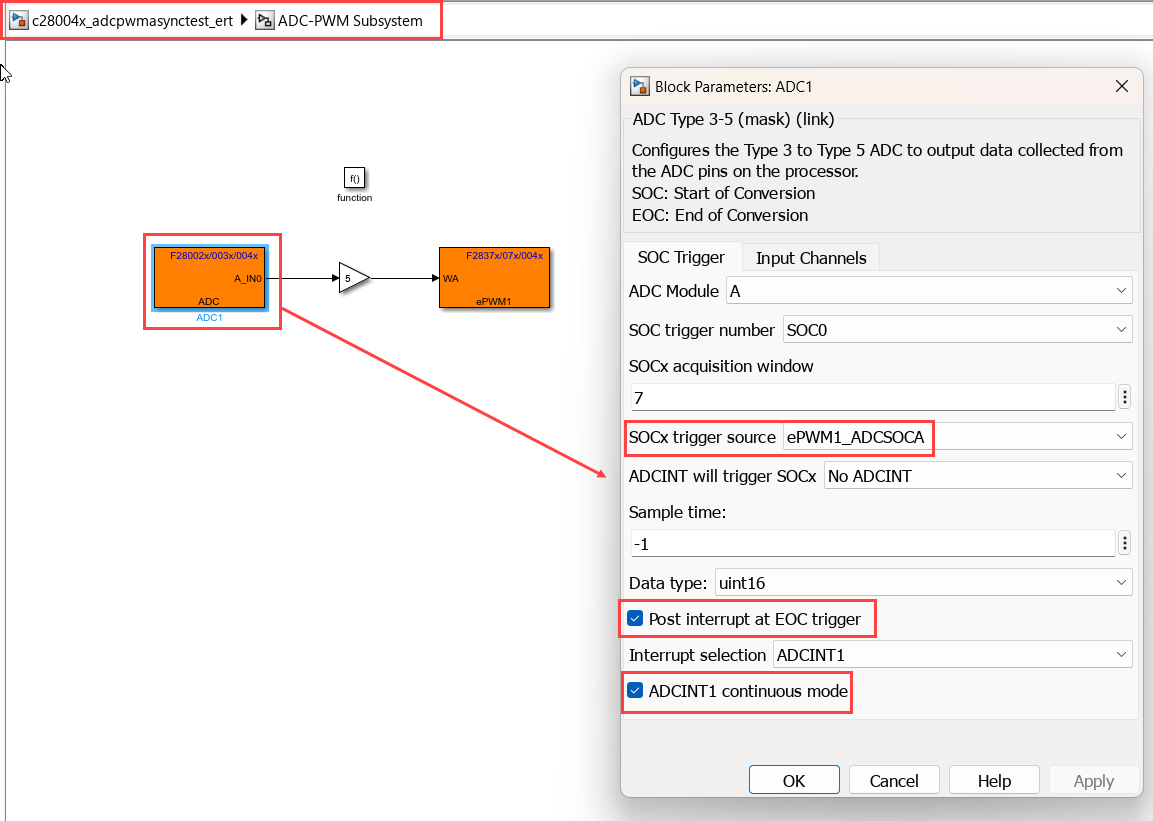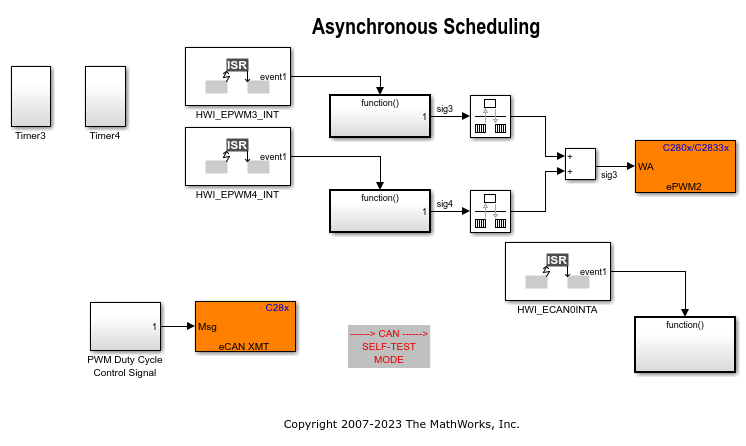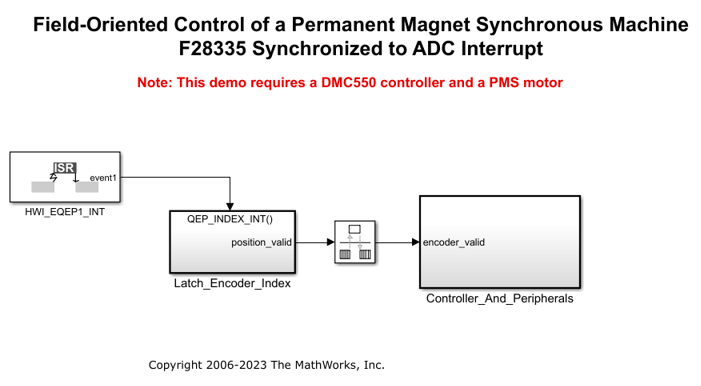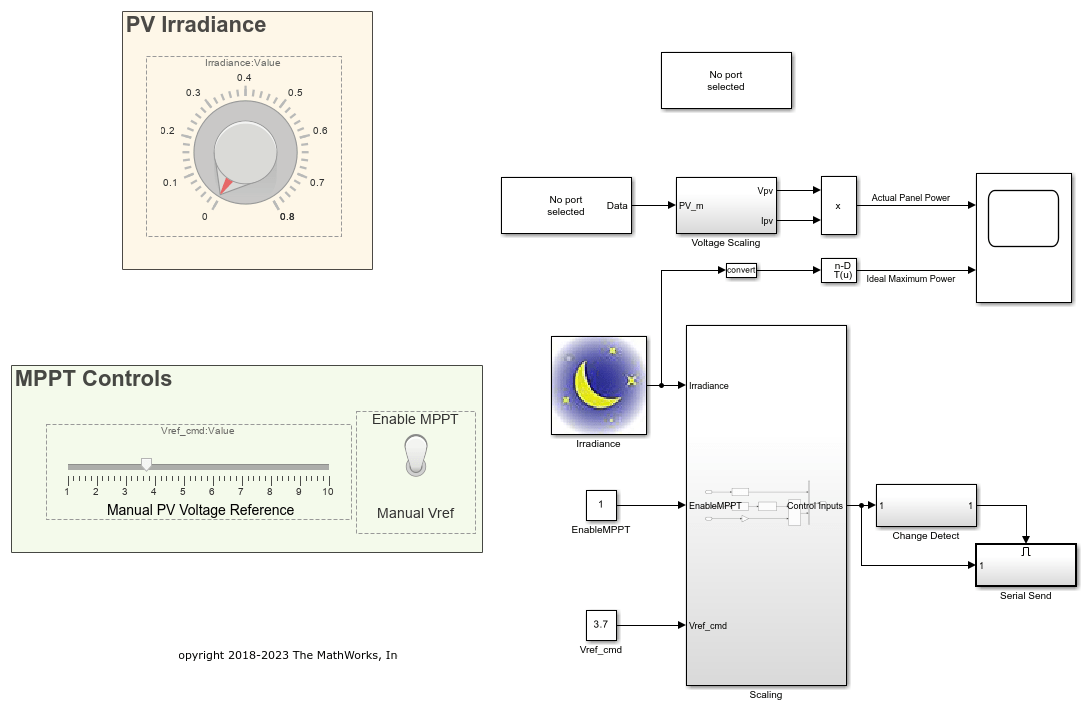PIE and CPU interrupt numbers
Each interrupt is described by a CPU interrupt number, a PIE interrupt number, a task
priority, and a preemption flag.
The CPU and PIE interrupt numbers together uniquely specify a single interrupt for a
single peripheral or peripheral module.
The PIE and CPU interrupt numbers for the c28x processors F280013x and F280015x that
support 12×8 interrupts are:
PIE and CPU Interrupt Numbers for F280013x and F280015x Processors
| PIE ⇒ | 1 | 2 | 3 | 4 | 5 | 6 | 7 | 8 |
|---|
| CPU ⇓ |
|---|
| 1 | ADCA1 | ADCC1 | - | XINT1 | XINT2 | SYS_ERR | TIMER0 | WAKE |
| 2 | EPWM1_TZ | EPWM2_TZ | EPWM3_TZ | EPWM4_TZ | EPWM5_TZ | EPWM6_ TZ | EPWM7_TZ | |
| 3 | EPWM1 | EPWM2 | EPWM3 | EPWM4 | EPWM5 | EPWM6 | EPWM7 | |
| 4 | ECAP1 | ECAP2 | - | - | - | - | - | |
| 5 | EQEP1 | - | - | - | - | - | - | |
| 6 | SPIA_RX | SPIA_TX | - | - | - | - | DCC0 | |
| 7 | - | - | - | - | - | - | - | - |
| 8 | I2CA | I2CA_FIFO | I2CB | I2CB_FIFO | SCIC_RX | SCIC_TX | - | - |
| 9 | SCIA_RX | SCIA_TX | SCIB_RX | SCIB_TX | CANA_0 | CANA_1 | - | - |
| 10 | ADCA_EVT | ADCA2 | ADCA3 | ADCA4 | ADCC_EVT | ADCC2 | ADCC3 | ADCC4 |
| 11 | - | - | - | - | - | - | - | - |
| 12 | XINT3 | XINT4 | XINT5 | - | FLSS_INT | - | - | - |
The PIE and CPU interrupt numbers for the TI processor F28P65x that support 12×16
interrupts are:
PIE and CPU Interrupt Numbers for F28P65x Processors
| PIE ⇒ | 1 | 2 | 3 | 4 | 5 | 6 | 7 | 8 |
|---|
| CPU ⇓ |
|---|
| 1 | ADCA1 | ADCB1 | ADCC1 | XINT1 | XINT2 | - | TIMER 0 | WAKE / WDOG |
| 2 | EPWM1_TZ | EPWM2_TZ | EPWM3_TZ | EPWM4_TZ | EPWM5_TZ | EPWM6_ TZ | EPWM7_TZ | EPWM8_TZ |
| 3 | EPWM1 | EPWM2 | EPWM3 | EPWM4 | EPWM5 | EPWM6 | EPWM7 | EPWM8 |
| 4 | ECAP1 | ECAP2 | ECAP3 | ECAP4 | ECAP5 | ECAP6 | ECAP7 | Reserved |
| 5 | EQEP1 | EQEP2 | EQEP3 | EQEP4 | CLB1 | CLB2 | CLB3 | CLB4 |
| 6 | SPIA_RX | SPIA_TX | SPIB_RX | SPIB_TX | LINA_0 | LINA_1 | LINB_0 | LINB_1 |
| 7 | DMA_CH1 | DMA_CH2 | DMA_CH3 | DMA_CH4 | DMA_CH5 | DMA_CH6 | EQEP_5 | EQEP_6 |
| 8 | I2CA | I2CA_FIFO | I2CB | I2CB_FIFO | UARTA_INT | UARTB_INT | EPWM17_TZ | EPWM18_TZ |
| 9 | SCIA_RX | SCIA_TX | SCIB_RX | SCIB_TX | DCANA_1 | DCANA_2 | EPWM17 | EPWM18 |
| 10 | ADCA_EVT | ADCA2 | ADCA3 | ADCA4 | ADCB_EVT | ADCB2 | ADCB3 | ADCB4 |
| 11 | CPU1_CLA1_1 | CPU1_CLA1_2 | CPU1_CLA1_3 | CPU1_CLA1_4 | CPU1_CLA1_5 | CPU1_CLA1_6 | CPU1_CLA1_7 | CPU1_CLA1_8 |
| 12 | XINT3 | XINT4 | XINT5 | CPU1_MPOST_INT | FLSS_INT | - | FPU_OVERFLOW | FPU_UNDERFLOW |
| PIE ⇒ | 9 | 10 | 11 | 12 | 13 | 14 | 15 | 16 |
|---|
| CPU ⇓ |
|---|
| 1 | I2CA | SYS_ERR | ECATSYNC0 | ECATINTn | CIPC0 | CIPC1 | CIPC2 | CIPC3 |
| 2 | EPWM9_TZ | EPWM10_ TZ | EPWM11_TZ | EPWM12_TZ | EPWM13_TZ | EPWM14_TZ | EPWM15_TZ | EPWM16_TZ |
| 3 | EPWM9 | EPWM10 | EPWM11 | EPWM12 | EPWM13 | EPWM14 | EPWM15 | EPWM16 |
| 4 | FSITXA_INT1 | FSITXA_INT2 | FSITXB_INT1 | FSITXB_INT2 | FSIRXA_INT1 | FSIRXA_INT2 | FSIRXB_INT1 | FSIRXB_INT2 |
| 5 | SDFM1 | SDFM2 | ECATRST | ECATSYNC1 | SDFM1DR1 | SDFM1DR2 | SDFM1DR3 | SDFM1DR4 |
| 6 | SPIC_RX | SPIC_TX | SPID_RX | SPID_TX | SDFM2DR1 | SDFM2DR2 | SDFM2DR3 | SDFM2DR4 |
| 7 | FSITXA_INT1 | FSITXA_INT2 | FSIRXA_INT1 | FSIRXA_INT2 | SDFM3DR1 | SDFM3DR2 | SDFM3DR3 | SDFM3DR4 |
| 8 | - | - | SDFM3 | SDFM4 | CLB5 | CLB6 | - | - |
| 9 | MCANSS_A0 | MCANSS_A1 | MCANSS_ECC_CORR_PLS | MCANSS_WAKE_AND_TS_PLS | PMBUSA | AES_INT | USBA | Reserved |
| 10 | ADCC_EVT | ADCC2 | ADCC3 | ADCC4 | Reserved | Reserved | Reserved | ADCHECKINT |
| 11 | MCANSS_B0 | MCANSS_B1 | MCANSS_BECC_CORR_PLS | MCANSS_B_WAKE_AND_TS_PLS | SDFM4DR1 | SDFM4DR2 | SDFM4DR3 | SDFM4DR4 |
| 12 | _ | ECAP6_INT2 | ECAP7_INT2 | - | CPU1_CRC_INT | CPU1_CLA1CRC_INT | CPU1_CLA OVER FLOW | CPU1_CLA UNDERFLOW |
The PIE and CPU interrupt numbers for the TI processor F28P55x that support 12×16
interrupts are:
PIE and CPU Interrupt Numbers for F28P55x Processors
| PIE ⇒ | 1 | 2 | 3 | 4 | 5 | 6 | 7 | 8 |
|---|
| CPU ⇓ |
|---|
| 1 | ADCA1 | ADCB1 | ADCC1 | XINT1 | XINT2 | SYS_ERR | TIMER 0 | WAKE / WDOG |
| 2 | EPWM1_TZ | EPWM2_TZ | EPWM3_TZ | EPWM4_TZ | EPWM5_TZ | EPWM6_ TZ | EPWM7_TZ | EPWM8_TZ |
| 3 | EPWM1 | EPWM2 | EPWM3 | EPWM4 | EPWM5 | EPWM6 | EPWM7 | EPWM8 |
| 4 | ECAP1 | ECAP2 | Reserved | Reserved | Reserved | Reserved | Reserved | Reserved |
| 5 | EQEP1 | EQEP2 | EQEP3 | Reserved | CLB1 | CLB2 | Reserved | Reserved |
| 6 | SPIA_RX | SPIA_TX | SPIB_RX | SPIB_TX | Reserved | Reserved | DCC0 | DCC1 |
| 7 | DMA_CH1 | DMA_CH2 | DMA_CH3 | DMA_CH4 | DMA_CH5 | DMA_CH6 | PMBUSA | Reserved |
| 8 | I2CA | I2CA_FIFO | I2CB | I2CB_FIFO | SCIC_RX | SCIC_TX | Reserved | Reserved |
| 9 | SCIA_RX | SCIA_TX | SCIB_RX | SCIB_TX | Reserved | Reserved | MCANASS0 | MCANASS1 |
| 10 | ADCA_EVT | ADCA2 | ADCA3 | ADCA4 | ADCB_EVT | ADCB2 | ADCB3 | ADCB4 |
| 11 | CLA1_1 | CLA1_2 | CLA1_3 | CLA1_4 | CLA1_5 | CLA1_6 | CLA1_7 | CLA1_8 |
| 12 | XINT3 | XINT4 | XINT5 | Reserved | FLSS_INT | Reserved | MCANASS_WAKE_AND_TS_PLS | MCANASS_ECC_CORR_PLS |
| PIE ⇒ | 9 | 10 | 11 | 12 | 13 | 14 | 15 | 16 |
|---|
| CPU ⇓ |
|---|
| 1 | ADCD1 | ADCE1 | Reserved | Reserved | Reserved | Reserved | Reserved | Reserved |
| 2 | EPWM9_TZ | EPWM10_ TZ | EPWM11_TZ | EPWM12_TZ | Reserved | Reserved | Reserved | Reserved |
| 3 | EPWM9 | EPWM10 | EPWM11 | EPWM12 | Reserved | Reserved | Reserved | Reserved |
| 4 | Reserved | Reserved | Reserved | Reserved | Reserved | Reserved | Reserved | Reserved |
| 5 | Reserved | Reserved | Reserved | Reserved | Reserved | Reserved | Reserved | Reserved |
| 6 | Reserved | Reserved | Reserved | Reserved | Reserved | Reserved | Reserved | Reserved |
| 7 | Reserved | Reserved | FSITXA_INT1 | FSITXA_INT2 | FSIRXA_INT1 | FSIRXA_INT2 | Reserved | Reserved |
| 8 | LINA_0 | LINA_1 | Reserved | Reserved | Reserved | Reserved | Reserved | Reserved |
| 9 | MCANBSS0 | MCANBSS1 | MCANBSS_ECC_CORR_PLS | MCANSS_WAKE_AND_TS_PLS | Reserved | Reserved | USB | NPU |
| 10 | ADCC_EVT | ADCC2 | ADCC3 | ADCC4 | ADCD_EVT | ADCD2 | ADCD3 | ADCD4 |
| 11 | ADCE_EVT | ADCE2 | ADCE3 | ADCE4 | Reserved | Reserved | Reserved | Reserved |
| 12 | _ | ECAP6_INT2 | ECAP7_INT2 | - | CPU1_CRC_INT | CPU1_CLA1CRC_INT | CPU1_CLA OVER FLOW | CPU1_CLA UNDERFLOW |
The following table lists the PIE and CPU interrupt numbers for the c28x processors
F280x, F2802x, F2803x, F2805x, F2806x, F2833x, F28M35x, and F28M36x that support 12×8
interrupts. The row headers 1–12 represent the CPU values, and the column headers 1–8
represent the PIE values.
PIE and CPU Interrupt Numbers for F280x, F2802x, F2803x, F2805x, F2806x,
F2833x, F28M35x, and F28M36x Processors
| PIE ⇒ | 1 | 2 | 3 | 4 | 5 | 6 | 7 | 8 |
|---|
| CPU ⇓ |
|---|
| 1 | SEQ1INT (ADC) / ADCINT1 | SEQ2INT (ADC) / ADCINT2 | Reserved | XINT1 | XINT2 | ADCINT / ADCINT9 | TINT0 (TIMER 0) | WAKEINT (LPM/WD) |
| 2 | EPWM1_TZINT | EPWM2_TZINT | EPWM3_TZINT | EPWM4_TZINT | EPWM5_TZINT | EPWM6_ TZINT | EPWM7_TZINT | EPWM8_TZINT |
| 3 | EPWM1_INT | EPWM2_INT | EPWM3_INT | EPWM4_INT | EPWM5_INT | EPWM6_ INT | EPWM7_INT | EPWM8_INT |
| 4 | ECAP1_INT | ECAP2_INT | ECAP3_INT | ECAP4_INT | ECAP5_INT | ECAP6_INT | EPWM10_TZINT / HRCAP1_INT | EPWM9_TZINT / HRCAP2_INT |
| 5 | EQEP1_INT | EQEP2_INT | EQEP3_INT | HRCAP3_INT | HRCAP4_INT | Reserved | EPWM10_INT | EPWM9_INT |
| 6 | SPIRXINTA (SPI-A) | SPITXINTA (SPI-A) | SPIRXINTB (SPIB_RX) / MRINTB (McBSP-B) | SPITXINTB (SPIB_TX) / MXINTB (McBSP-B) | SPIRXINTC (SPI-C) / MRINTA (McBSP-A_RX) | SPITXINTC (SPI-C) / MXINTA (McBSP-A_TX) | SPIRXINTD (SPI-D) / EPWM12_TZINT | SPITXINTD (SPI-D) / EPWM11_TZINT |
| 7 | DINTCH1 (DMA1) | DINTCH2 (DMA2) | DINTCH3 (DMA3) | DINTCH4 (DMA4) | DINTCH5 (DMA5) | DINTCH6 (DMA6) | EPWM12_INT | EPWM11_INT |
| 8 | I2CINT1A | I2CINT2A | Reserved | Reserved | SCIRXINTC (SCI-C) | SCITXINTC (SCI-C) | Reserved | Reserved |
| 9 | SCIRXINTA (SCIA_RX) | SCITXINTA (SCIA_TX) | SCIRXINTB (SCIB_RX) / LINA_INT0 | SCITXINTB (SCIB_TX) / LINA_INT1 | ECAN0INTA (CANA_1) | ECAN1INTA (CANA_2) | ECAN0INTB (CANB_1) | ECAN1INTB (CANB_2) |
| 10 | EPWM9_TZINT / ADCINT1 | EPWM10_TZINT / ADCINT2 | EPWM11_TZINT / ADCINT3 | EPWM12_TZINT / ADCINT4 | EPWM13_TZINT / ADCINT5 | EPWM14_TZINT / ADCINT6 | EPWM15_TZINT / ADCINT7 | EPWM16_TZINT / ADCINT8 |
| 11 | CLA1_INT1 / EPWM9_INT7 / MTOCIPCINT1 | CLA1_INT2 / EPWM10_INT / MTOCIPCINT2 | CLA1_INT3 / EPWM11_INT / MTOCIPCINT3 | CLA1_INT4 / EPWM12_INT / MTOCIPCINT4 / | CLA1_INT5 / EPWM13_INT | CLA1_INT6 / EPWM14_INT | CLA1_INT7 / EPWM15_INT | CLA1_INT8 / EPWM16_INT |
| 12 | XINT3 | XINT4 / C28FLSINGERR | XINT5 | XINT6 / C28RAMSINGERR | XINT7 / C28RAMACCVIOL | Reserved | LVF | LUF |
The PIE and CPU interrupt numbers for the c28x processors F2807x, F2837xS, F2837xD,
F2838x, F28004x, F28002x, and F28003x that support 12×16 interrupts are:
PIE and CPU Interrupt Numbers for F2807x, F2837xS, F2837xD, F2838x, F28004x,
F28002x, and F28003x Processors
| PIE ⇒ | 1 | 2 | 3 | 4 | 5 | 6 | 7 | 8 |
|---|
| CPU ⇓ |
|---|
| 1 | ADCA1 | ADCB1 | ADCC1 | XINT1 | XINT2 | ADCD1 | TIMER 0 | WAKE / WDOG |
| 2 | EPWM1_TZ | EPWM2_TZ | EPWM3_TZ | EPWM4_TZ | EPWM5_TZ | EPWM6_ TZ | EPWM7_TZ | EPWM8_TZ |
| 3 | EPWM1 | EPWM2 | EPWM3 | EPWM4 | EPWM5 | EPWM6 | EPWM7 | EPWM8 |
| 4 | ECAP1 | ECAP2 | ECAP3 | ECAP4 | ECAP5 | ECAP6 | ECAP7 | Reserved |
| 5 | EQEP1 | EQEP2 | EQEP3 | Reserved | CLB1 | CLB2 | CLB3 | CLB4 |
| 6 | SPIA_RX | SPIA_TX | SPIB_RX | SPIB_TX | MCBSPA_RX | MCBSPA_TX | MCBSPB_RX | MCBSPB_TX |
| 7 | DMA_CH1 | DMA_CH2 | DMA_CH3 | DMA_CH4 | DMA_CH5 | DMA_CH6 | Reserved | Reserved |
| 8 | I2CA | I2CA_FIFO | I2CB | I2CB_FIFO | SCIC_RX | SCIC_TX | SCID_RX | SCID_TX |
| 9 | SCIA_RX | SCIA_TX | SCIB_RX | SCIB_TX | CANA_0 | CANA_1 | CANB_0 | CANB_1 |
| 10 | ADCA_EVT | ADCA2 | ADCA3 | ADCA4 | ADCB_EVT | ADCB2 | ADCB3 | ADCB4 |
| 11 | CLA1_1 | CLA1_2 | CLA1_3 | CLA1_4 | CLA1_5 | CLA1_6 | CLA1_7 | CLA1_8 |
| 12 | XINT3 | XINT4 | XINT5 | MPOST | FMC.DONE | VCU | FPU_OVERFLOW | FPU_UNDERFLOW |
| PIE ⇒ | 9 | 10 | 11 | 12 | 13 | 14 | 15 | 16 |
|---|
| CPU ⇓ |
|---|
| 1 | I2CA | SYS_ERR | ECATSYNC0 (CPU1 only) | ECATINTn (CPU1 only) | IPC0/CIPC0 | IPC1/CIPC1 | IPC2/CIPC2 | IPC3/CIPC3 |
| 2 | EPWM9_TZ | EPWM10_ TZ | EPWM11_TZ | EPWM12_TZ | EPWM13_TZ | EPWM14_TZ | EPWM15_TZ | EPWM16_TZ |
| 3 | EPWM9 | EPWM10 | EPWM11 | EPWM12 | EPWM13 | EPWM14 | EPWM15 | EPWM16 |
| 4 | FSITXA_INT1 | FSITXA_INT2 | FSITXB_INT1 | FSITXB_INT2 | FSIRXA_INT1 | FSIRXA_INT2 | FSIRXB_INT1 | FSIRXB_INT2 |
| 5 | SD1 / SDFM1 | SD2/SDFM1 | ECATRSTINTn (CPU1 only) | ECATSYNC1 (CPU1 only) | SDFM1DR1 | SDFM1DR2 | SDFM1DR3 | SDFM1DR4 |
| 6 | SPIC_RX | SPIC_TX | SPID_RX | SPID_TX | SDFM2DR1 | SDFM2DR2 | SDFM2DR3 | SDFM2DR4 |
| 7 | FSIRXC_INT1 | FSIRXC_INT2 | FSIRXD_INT1 | FSIRXD_INT2 | FSIRXE_INT1 | FSIRXE_INT2 | FSIRXF_INT1 | FSIRXF_INT2 |
| 8 | LINA_0/FSIRXG_INT1 | LINA_1/FSIRXG_INT2 | FSIRXH_INT1 | FSIRXH_INT2 | PMBUSA/CLB5 | CLB6 | UPPA (CPU1 only)/CLB7 | CLB8 |
| 9 | MCANSS_INT0(CPU1 only) | MCANSS_INT1 (CPU1 only) | MCANSS_ECC_CORR_PUL_INT (CPU1 only) | MCANSS_WAKE_AND_TS_PLS_INT (CPU1 only) | PMBUSA | CM_STATUS (CPU1 only) | USBA (CPU1 only) | Reserved |
| 10 | ADCC_EVT | ADCC2 | ADCC3 | ADCC4 | ADCD_EVT | ADCD2 | ADCD3 | ADCD4 |
| 11 | CMTOCPUxIPCINTR0 | CMTOCPUxIPCINTR1 | CMTOCPUxIPCINTR2 | CMTOCPUxIPCINTR3 | CMTOCPUxIPCINTR4 | CMTOCPUxIPCINTR5 | CMTOCPUxIPCINTR6 | CMTOCPUxIPCINTR7 |
| 12 | EMIF_ ERROR | RAM_CORRECTABLE_ERROR/ECAP6INT2 | FLASH_CORRECTABLE_ERROR/ECAP7INT2 | RAM_ACCESS_VIOLATION | SYS_PLL_ SLIP/CPUxCRC_INT | AUX_PLL_SLIP//CLA1CRC_INT | CLA OVER FLOW | CLA UNDERFLOW |
The PIE and CPU interrupt numbers for the c281x processors are:
PIE and CPU Interrupt Numbers for C281x Processors
| PIE ⇒ | 1 | 2 | 3 | 4 | 5 | 6 | 7 | 8 |
|---|
| CPU ⇓ |
|---|
| 1 | PDPINTA (EV-A) | PDPINTB (EV-B) | Reserved | XINT1 | XINT2 | ADCINT (ADC) | TINT0 (TIMER 0) | WAKEINT (LPM/WD) |
| 2 | CMP1INT (EV-A) | CMP2INT (EV-A) | CMP3INT (EV-A) | T1PINT (EV-A) | T1CINT (EV-A) | T1UFINT (EV-A) | T1OFINT (EV-A) | Reserved |
| 3 | T2PINT (EV-A) | T2CINT (EV-A) | T2UFINT (EV-A) | T2OFINT (EV-A) | CAPINT1 (EV-A) | CAPINT2 (EV-A) | CAPINT3 (EV-A) | Reserved |
| 4 | CMP4INT (EV-B) | CMP5INT (EV-B) | CMP6INT (EV-B) | T3PINT (EV-B) | T3CINT (EV-B) | T3UFINT (EV-B) | T3OFINT (EV-B) | Reserved |
| 5 | T4PINT (EV-B) | T4CINT (EV-B) | T4UFINT (EV-B) | T4OFINT (EV-B) | CAPINT4 (EV-B) | CAPINT5 (EV-B) | CAPINT6 (EV-B) | Reserved |
| 6 | SPIRXINTA (SPI) | SPITXINTA (SPI) | Reserved | Reserved | MRINT (McBSP) | MXINT (McBSP) | Reserved | Reserved |
| 7 | Reserved | Reserved | Reserved | Reserved | Reserved | Reserved | Reserved | Reserved |
| 8 | Reserved | Reserved | Reserved | Reserved | Reserved | Reserved | Reserved | Reserved |
| 9 | SCIRXINTA (SCI-A) | SCITXINTA (SCI-A) | SCIRXINTB (SCI-B) | SCITXINTB (SCI-B) | ECAN0INT (CAN) | ECAN1INT (CAN) | Reserved | Reserved |
| 10 | Reserved | Reserved | Reserved | Reserved | Reserved | Reserved | Reserved | Reserved |
| 11 | Reserved | Reserved | Reserved | Reserved | Reserved | Reserved | Reserved | Reserved |
| 12 | Reserved | Reserved | Reserved | Reserved | Reserved | Reserved | Reserved | Reserved |





